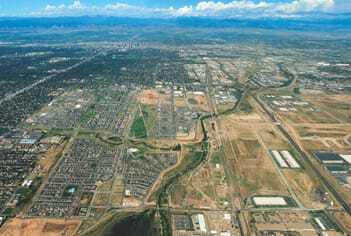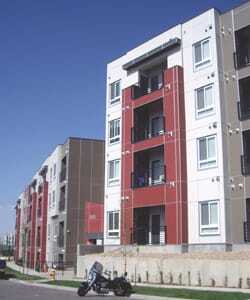The seeds of Stapleton, a mixed-use community of homes, restaurants, and commercial and industrial space, were planted in 1989 when Denver voted to build a new airport to replace Stapleton International Airport. The community is now ten years old; the first residents having moved in during May 2002. The earliest neighborhoods have matured, providing 4,800 homes to 12,000 residents, and new neighborhoods are burgeoning. The community is presently made up of seven neighborhoods, eight schools, a library, and a recreation center, along with 150 shops, service businesses, and restaurants. Every home is within a ten-minute walk of open space. Eighty percent of Stapleton children walk to school and 93 percent of homes participate in Denver’s recycling program. More than 27,000 trees have been planted and 6 million tons of concrete that once formed the airport’s runways have been recycled. The development generates $22 million in annual property taxes and $13 million in sales tax revenue.
In 1990, the Stapleton Development Foundation was established and partnered with the city to create the Green Book, the framework that has guided all redevelopment of the 4,700-acre (1,900 ha) former airport site. In 1995, the city created the Stapleton Development Corporation (SDC), a private sector, nonprofit entity, to oversee the disposition of the former airport. SDC continues to work with Forest City Enterprises Inc., which won a 1998 competition to be master developer, in redevelopment of 4,200 acres (1,700 ha) of the site. This organizational structure is viewed as successful, says John Lehigh, president and CEO of Forest City Stapleton, with the role of SDC slowly contracting as Stapleton’s development progresses. Prologis owns the remaining 500 acres, which have been developed as light-industrial/flex space.
Residential Market
Forest City is predicting homes sales of about 500 for this year, up from 380 in 2011. More than 30 percent of sales in 2009 were attributed to people moving up to larger homes within Stapleton, indicating a desire by people living there to stay there. Current new home prices range from the low $100,000s to $800,000. Builders are obtaining U.S. Environmental Protection Agency Energy Star scores 20 to 50 percent higher than average, and several zero-energy homes have been constructed. The average resale value in the first quarter of this year was $421,000, compared with the Denver metro area average of $281,000. Homes sold more quickly in Stapleton, too, remaining on the market an average of 82 days in the first quarter, compared with 101 days for the Denver metro area.
Stapleton has homes built by 18 production builders and six semicustom builders. Forest City plans to take residential construction north of Interstate 70 this year, adding 4,000 for-sale homes in the area. In addition, about 650 homes are slated to be built south of I-70, including an area that had been planned in part as office space.
Originally, Forest City was adamant about having traditional Denver styles reflected in the single-family architecture, but development has evolved to allow more diverse traditional styles as well as modern architecture among the for-sale home inventory. The diversification was introduced in townhouses and eventually shifted to single-family detached homes. Some of the initial traditional styles will be dropped altogether as development moves north of I-70, and a more monostylistic, block-face layout approach will be explored, says Heidi Majerik, director of development at Forest City Stapleton. Forest City is also providing more single-story models as options for the significant number of parents wanting to relocate to Stapleton from in and out of state to be closer to their children and grandchildren.
Commercial Real Estate Market
| An aerial view of the Stapleton site in 2011. |
One of the first projects completed at the redeveloped Stapleton, Quebec Square, a 75-acre (30 ha) regional retail center built to provide the tax increment for infrastructure improvements, was sold by Forest City earlier this year for $34.25 million. The sale generated net proceeds of about $8 million, resulting in an effective cap rate of 6.4 percent, based on 2011 net operating income. The first neighborhood retail area, known as East 29th Avenue Town Center, has prospered with restaurant and service uses: it is 100 percent leased, with rates in the low to mid-$20-per-square-foot range, triple net. Plans for a second neighborhood retail center remain stalled as Forest City continues to look for a grocery anchor.
Multifamily development is strong. A new 85-unit market-rate rental project, the Aster Town Center, came on line in May with 50 percent of its units leased within the first month. A second phase will be 140 units. The Botanica Eastbridge, the second new rental project, will add another 118 units by this fall. This project is located in southeastern Stapleton, providing a new choice for the 18 percent of Stapleton renters who are associated with the adjacent Anschutz Medical Campus and Fitzsimons Life Science District, the redevelopment of the former Fitzsimons Army Medical Center.
A third rental project—in the planning stages north of I-70—is projected to include up to 750 units in three phases, with the first units expected to come on line in summer 2013. A fourth, higher-end and higher-density rental project, with about 260 units at 45 units per acre, is envisioned on a vacant site abutting the original town green. In addition, a 92-unit affordable housing development, Bluff Lake Apartments, developed by local nonprofit Mercy Housing, was added this year and is restricted to people earning 30 to 50 percent of the area median income. The project includes 46 units set aside for Denver’s Road Home homelessness intervention program to provide permanent housing for transitional homeless families. The Stapleton Affordable Housing Plan calls for 10 percent of for-sale homes and 20 percent of rental homes to be income qualified. Currently, 278 rental units at Stapleton are designated as affordable housing.
Together these projects will result in nearly 1,500 rental units added to Stapleton within four years. According to Jim Chrisman, senior vice president of Forest City Stapleton, rents at Stapleton increased an average of 9.7 percent from second quarter of 2011 to the same period this year as demand rose, and Stapleton has an average 95 percent occupancy rate. Forest City is also looking into the possibility of providing independent living and assisted living facilities to house extended families living at Stapleton and to accommodate the increase in the number of people aging in place and general demographic trends.
The Need for Flexibility
As is the case with any large-scale development, flexibility is needed. Forest City continues to be on schedule, with about 50 percent of the land absorbed and another ten years of construction planned. Nevertheless, there have been some changes to the original land plan. Most notably, the Central Park West neighborhood, originally envisioned as a large office node north of the first neighborhood center, will be used for residential development because the office market lagged significantly in Stapleton’s first ten years.
| Bluff Lake Apartments, an affordable rental development that opened this spring. |
Recently completed and planned transportation infrastructure supports a new vision for three office centers at Stapleton. The Central Park Boulevard interchange with I-70 and its related bridge over Sand Creek and the Union Pacific rail line opened this spring, connecting north and south Stapleton much more effectively. This $70 million project will literally pave the way for additional development north of I-70 as well as between I-70 and the rail line. Further, the 22.8-mile (36.7 km) commuter rail transit corridor from downtown to Denver International Airport is under construction and expected to be in service in 2016. This East Rail Line includes Stapleton’s Central Park Station. These three new focus areas—Northfield Business Park, Centerfield Business Park, and Central Park Station—include 235 acres (95 ha) of business-ready land for office and transit-oriented development within Stapleton. Forest City is banking on significant demand for and development of four- to 11-story buildings within these three areas.
Stapleton was the 11th-best-selling master-planned community in the United States last year, according to John Burns Real Estate Consulting. The redevelopment of Stapleton has “been an economic success for Denver,” says Lehigh of Forest City, allowing Denver to grow and compete with other new-construction development in the metro area. Perhaps more important, it has provided for significant urban infill development that otherwise would have occupied greenfield sites.






